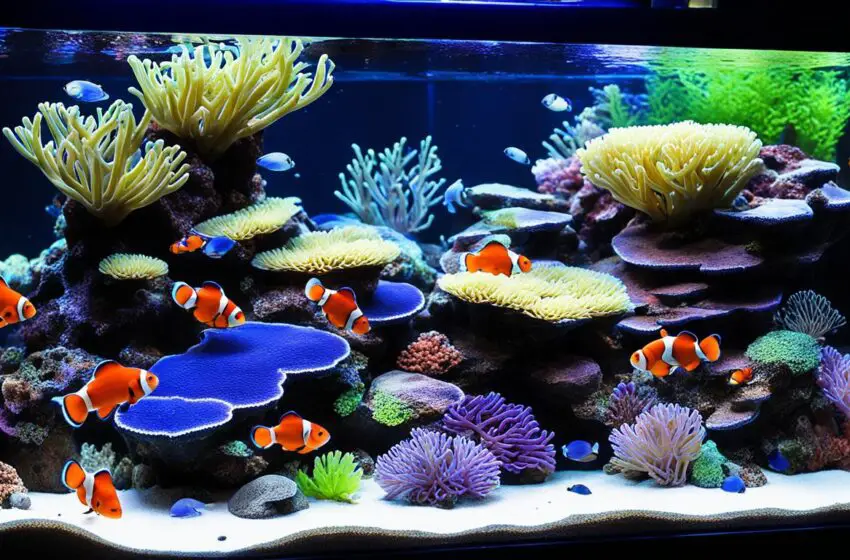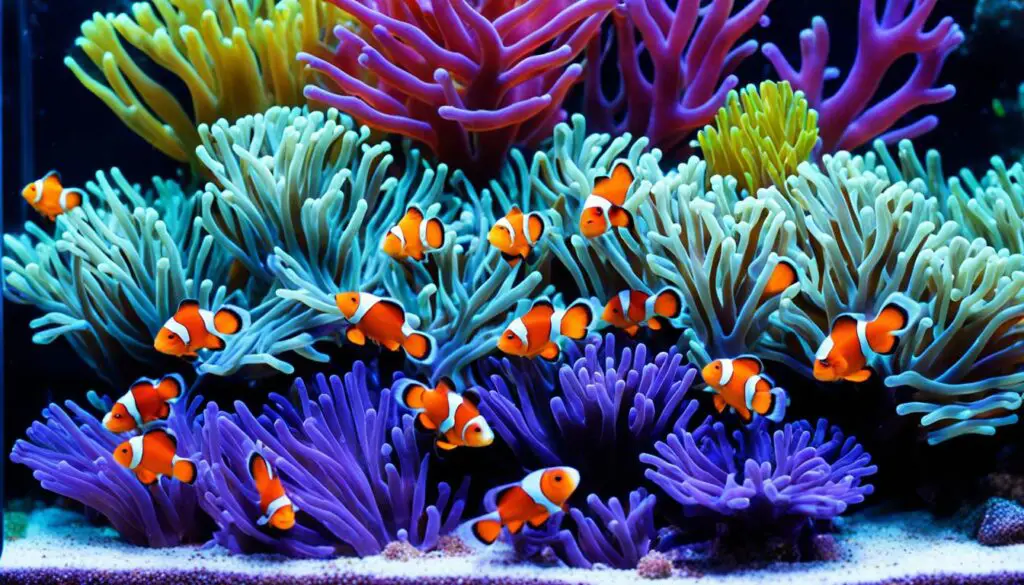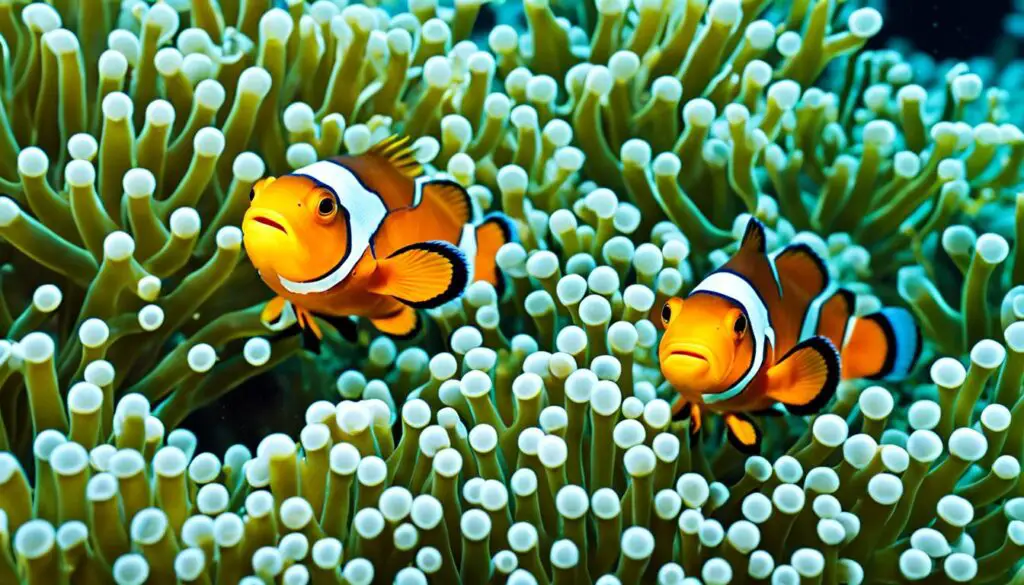Meet Your New Pet Fish: Clownfish Care Essentials

Welcome to the exciting world of fish owning! If you’re thinking about a new pet, clownfish are great friends. They are known for their bright colors, special markings, and fun behaviors. I’ll guide you on taking care of clownfish, covering everything from where they live to what they eat.
Clownfish are very popular in saltwater aquariums. Their orange and white colors stand out. They also have a cool link with sea anemones. Note, not all clownfish can live with all anemone types. It’s important to pick the right match.
If you dream of a lively fish tank, you might ask about tank buddies for clownfish. Though some clownfish can share a tank with damselfish, enough room is key to avoid fights. Also, if you get a mated pair, you might see baby fish, which is very exciting.
Now, for caring for your new clownfish. They are good for beginners and can live a long time, up to 20 years. So, this is a commitment for the future.
To make your clownfish happy, they need a good place to live. A tank that holds at least 29 gallons is best. You must keep the water warm, between 74-80°F, and the salt level and pH just right for them.
Other than the tank, you’ll need some supplies. A big enough tank, the right food, decorations, water cleaner, salt, filter, and more. These things create a healthy and enjoyable home for your fish.
Choosing the Right Tank Setup for Clownfish
Keeping clownfish as pets means you must set up their tank carefully. The right size of aquarium, the right room placement, and suitable friends are key. Read on to learn how to create a perfect home for your clownfish.
Aquarium Size and Placement
A minimum tank size of 29 gallons is needed for clownfish. This ensures they have plenty of room to move and have their own space. A large bottom area is also key for them to explore and hide in.
Place your aquarium in a spot away from bright sunlight, windows, and vents. This keeps the environment stable and avoids sudden temperature changes.
Suitable Tankmates
Some clownfish varieties can live alone or in pairs, while others can join with other certain fish. It’s vital to research the fish you want to keep. Make sure their tank buddies won’t stress them out.
Filtration and Water Health
Setting up a good filter is important. It keeps the water clean by removing harmful substances. Hang-on-back and canister filters work well for this.
Test the water regularly to check if it’s safe for your clownfish. Keep an eye on salt level, temperature (74-80°F), and pH (7.8-8.4). This helps to keep the water and your fish healthy.
Decor and Substrate
Clownfish need hiding places. Decorate their tank with live rock, caves, and plants. These not only make the tank look nice but also feel cozy for your pet fish.
Rinse the substrate and decor well before you put them in the tank. Live rock can also help keep the water clean by acting as a filter.
Temperature and Monitoring
Keep the water at a stable 74-80°F with a good heater. Use a thermometer to make sure the temperature doesn’t change too much. This is ideal for your clownfish’s health.
Protein Skimmer and Maintenance
A protein skimmer is great for the water quality and keeps oxygen levels high. Don’t forget, a clean tank is a must. Regular cleanings, water changes, and filter checks are vital for your clownfish to thrive.
By considering all these aspects, you can make a perfect home for your clownfish. Watch how they interact with their tank. Enjoy this fascinating journey of caring for your clownfish.
| Tank Setup Essentials | Details |
|---|---|
| Aquarium Size | Minimum capacity of 29 gallons |
| Tankmates | Choose compatible species |
| Filtration | Hang-on-back or canister filters |
| Water Parameters | Regular testing, appropriate salt content, temperature, pH levels |
| Decor and Substrate | Live rock, substrate, caves, plants |
| Temperature | 74-80°F with a reliable heater |
| Protein Skimmer | Supports water quality and oxygen levels |
| Maintenance | Regular cleaning, water changes, filter replacements |
Feeding and Caring for Clownfish
Feeding your clownfish means giving them a mix of foods. They eat small crustaceans, copepods, and algae. Also, they like fish eggs, anemone, larvae, and various shrimps. Make sure to feed them spirulina flakes or pellets. This mix keeps them healthy and happy.
Give clownfish their feeding spot to avoid sharing with others. Teenage clownfish eat three to four times daily. Adults eat once or twice. Watch how much they eat and adjust as needed to keep them in good shape.
Choosing friends for your clownfish matters. They get along with some species but not their own kind. Good tankmates include gobies and cardinalfish. Do your homework to make sure they’ll be friends.
As a responsible clownfish owner, it’s our ethical responsibility to provide a suitable living environment and ensure the well-being of our beloved aquatic pets.
For healthy clownfish, your tank must be right. They need at least a 29-gallon space. Water should be 74-80°F. Keep the salt level at 1.020-1.025.
Get clownfish that were born in captivity. This helps protect wild fish. These fish adjust to home tanks better, even for new fish owners.
Clownfish are good for kids and adults. They teach about the sea and caring for it. They are strong and can live in smaller tanks.

By feeding them right, picking the right friends, and caring for their tank, your clownfish will do well. It’s your duty to take good care of them. This helps them and keeps your home aquarium happy.
Conclusion
Creating a great home for your clownfish is key to their happiness and health. You need to think about the tank’s size, the right friends for them, water cleaning, and their comfort. Make their tank feel like their ocean home, and they’ll be happy.
Clownfish are great for those new to fishkeeping. But, they still need special care. This means feeding them well and keeping their tank just right. By doing this, your fish will live well and add beauty to your life.
It’s best to pick clownfish that were born in tanks than taken from the sea. This helps keep their wild homes safe and makes them adjust better to your tank. Also, having them at home is a chance to learn about protecting nature.
Keeping the fish tank clean and in good shape is a must. Change the water often, keep the filters fine, and watch how your fish act. This way, your clownfish will be healthy and flourish, becoming happy additions to your family.
FAQ
Can clownfish live with other fish?
Clownfish can live with damselfish if the tank is big and conditions are right. It’s crucial to pick the right tankmates and watch for fighting among the clownfish.
What size aquarium do clownfish need?
Clownfish need at least a 29-gallon tank. They need room to swim and claim their own space. More bottom area is better for their happiness.
How do I maintain water quality in a clownfish tank?
Use a good filter to keep the water clean. Hang-on-back and canister filters work well. Also, check water often, change some water, and keep the salt level right.
What temperature should the water be in a clownfish tank?
The water should be 74-80°F for clownfish. Use a heater to keep it steady and a thermometer to check.
What do I feed clownfish?
Clownfish eat a mix of foods like shrimp, algae, and fish eggs. Feed juveniles 3-4 times daily.
Can I keep clownfish with other species of fish?
Some clownfish can live with other fish, but choose carefully. Research to pick the best friends for your clownfish.
How often should I clean the clownfish tank?
Clean the tank regularly for happy clownfish. This means changing water, checking the filter, and watching your fish. Follow a set cleaning schedule.



